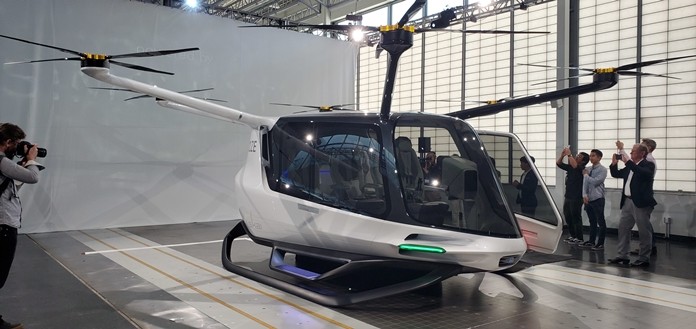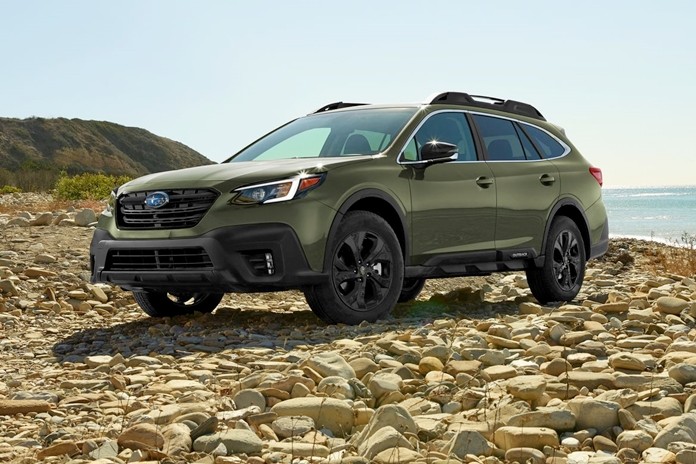
Los Angeles (AP) — Will hydrogen-powered electric flying vehicles someday serve as taxis, cargo carriers and ambulances of the sky, but wait, as experts say they will have to clear a number of regulatory hurdles before being approved for takeoff years in the future.
With six rotors on the roof and seats inside for five people, a passenger model of the Skai (pronounced “sky”) unveiled near Los Angeles resembles an oversized drone crossed with a luxury SUV.
Like a drone, the vehicle from Alaka’i Technologies takes off and lands vertically. It’s one of many similar electric flying crafts in production, including prototypes from Boeing and Airbus that made successful test flights this year, according to Vertical Flight Society, an industry group. Mind you, Boeing has enough problems on its plate right now.
Most are powered by batteries, which can add a lot of weight. The Skai instead uses very light hydrogen fuel cells to run its rotors, giving it a range of 400 miles (644 kilometers) and the capacity to carry 454 kilograms in people or freight.
The test flight would be flown by an on-board pilot using a pair of joysticks, but the technology exists to eventually fly it remotely and even autonomously. (Now Mr Skai, take me home.)
Regulators are still grappling with the proliferation of smaller drones — those under about 50 pounds flown by hobbyists and filmmakers.
Drone-like vehicles such as the Skai must first simply prove their airworthiness, like any common plane. After that, getting commercial certification is another convoluted process.
“The technology is interesting, but the regulatory road will be very long adding that the idea of allowing people to fly in a large aircraft without a pilot is “well outside the current regulatory regime.”
It could take at least a decade before the company realizes its vision of a fleet of electric flying vehicles ferrying passengers over major cities at nearly 200 kph.
The manufacturer says Skai aircraft could be used by first responders to send in food or water following disasters like hurricanes or wildfires that can destroy infrastructure. It could be used as an ambulance and to evacuate people. Outfitted with a transmitter, one could serve as a mobile cell tower, hovering for up to 10 hours over a neighborhood to provide communication services.
Big brother is watching you
Detroit (AP) — Would you pay more for a car or SUV that warns you if you’re falling asleep or not paying attention behind the wheel?
Auto companies are figuring that because your life could depend on it, you will.
As safety features such as automatic emergency braking and lane-centering make their way from luxury vehicles down to lower-cost rides for the masses, distracted driver alert systems are coming with them. At last month’s New York International Auto Show, Hyundai and Subaru both announced such systems in mainstream vehicles.
Every day, at least nine people are killed in the U.S. and 100 are injured in distracted driving crashes, according to the National Safety Council. Drivers who are preoccupied by cellphones, dashboard touch screens and other distractions caused 3,157 fatal crashes in the U.S. in 2016, the latest year that government statistics were available. That’s 9 percent of all fatal crashes in the country.
Distracted driver alert systems started showing up in luxury cars about a decade ago. Mercedes-Benz had a system that displayed a lighted coffee cup icon on the dashboard. Over the years they’ve become more sophisticated and made their way into mainstream vehicles, usually on pricier versions.
For instance, Subaru’s “DriverFocus Distraction Mitigation System” uses a dashboard camera to watch the driver’s eyes and face. If it sees the driver is looking away from the front of the vehicle for an extended period, it will beep and show the message “Keep eyes on road” on the dashboard. The system watches for heads nodding or someone talking on the phone or texting, or even looking into the back seat, said Subaru spokesman Ron Kiino.
On the newly redesigned 2020 Outback Subaru SUV, the system will be standard on the three priciest versions, the Touring, Touring XT and the Limited XT, and it will be an option on the Limited, the lowest cost version with leather seats. No prices for those models have been announced, and it won’t be available on cheaper versions.

The Subaru system made its debut as standard equipment on the luxury version of its Forester SUV for the 2019 model year. To get it, you have to buy the priciest version, the Touring, which starts at USD 35, 270, more than USD 10,000 above the lowest-priced model.
Hyundai’s system is standard on the Venue, an entry-level SUV that will start under USD 19,000. It doesn’t watch the driver’s face. Instead, it uses the same front-facing camera as the standard automatic emergency braking and lane assist. If you swerve or veer, the Venue’s software will sound a bell and the dash display will politely show a coffee cup and the words “Take a Break.”
Hyundai’s market research found that people want the feature, said Mike Evanoff, senior manager of product planning. “It’s just another layer that’s a ‘got your back’ kind of thing,” he said.
The warning system is already on Hyundai’s Veloster sports car and will make its way to the entire lineup as vehicles are updated and outfitted with standard automatic emergency braking by September of 2022 in an industry agreement with the U.S. government.
Subaru, which has made safety a cornerstone of its marketing efforts, says its buyers are safety conscious and will be interested in the feature, even if it costs more. And if the system is too annoying, customers can turn it off.
Other systems on luxury vehicles are more sophisticated. The one on Cadillac’s Super Cruise semi-autonomous system makes sure the driver is paying attention and will even pull to the side of the road if they aren’t. Mercedes’ Attention Assist system tracks more than 70 variables including time of day, elapsed driving time and steering movement to determine if a driver is tired or not paying attention. When a certain threshold is reached, it issues audible and visible warnings.
The devices are proliferating as vehicles make the transition from human drivers to full automation. Systems like Tesla’s Autopilot and Super Cruise, which control steering, braking and speed under certain conditions, are steps toward autonomous cars, but they can’t drive themselves because humans must be ready to take over.
Vettel to call it a day?
Ferrari’s number 1 is the four times world champion Sebastian Vettel, however he has now got a reputation for silly mistakes, something not expected of world champions.
Coupled with that is the fact that the new Number 2, Charles Leclerc, is faster than Vettel, and is being held back by the Ferrari pit wall which is now known for making strange decisions in Vettel’s favor. These are such as making LeClerc give way to Vettel; not sending the youngster out for qualifying, but leaving him in the garage; and sending him out on hard rubber, known to be slower than the mediums they fitted to Vettel’s car.

If Ferrari continue to hold Leclerc back, he will leave Ferrari. If Ferrari stop shielding Vettel, the four times champion will call it a day, rather than lose his position in the team and incidentally, lose much face as well.
If Vettel does resign, who would step in beside the young charger? The best fit would be Ricciardo, but I am sure Renault will have him on a watertight contract for a few seasons yet. Other drivers who could be available would include Ocon who was forced to sit out this year as there were no teams with vacancies. Where he should have been was the team previously known as Force India, before being bought by Lance Stroll’s father who gifted the seat to his son.
Whilst Ferrari is everyone’s sentimental favorite, the Scuderia is also well known for monumental stuff-ups from the pit wall, and this year has been no exception.
Autotrivia Quiz
Last week I asked, what is the connection between Alberto Ascari and Paul Hawkins? An easy one – both crashed into the harbor at Monaco.
So to this week. What does FEV 2H and the Springfield Boys Club have in common?
Be the first correct answer to email [email protected] or [email protected]. Good luck!




